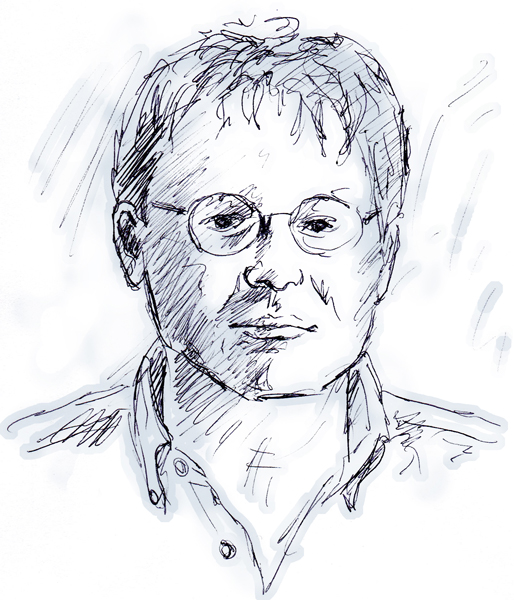Coming to Philosophic Pragmatism and Metaphor
by Mark Staff Brandl

I recently listened to a podcast interview on “The Philosophers’ Zone” with quantum physicist Christopher Fuchs (link), who is also an adherent of Philosophical Pragmatism (the school of thought, not just the common use of it as an adjective). I was thoroughly excited by the interview. I am an artist and art historian and “metaphorician,” but those who read this website may have noted that I am a Cornel-Westian, Jamesian, Deweyian Pragmatist as well. I also have always had a great amateur interest in physics (as well as archaeology and philosophy) — listening to podcasts about it while painting and so on.
I wrote to him and he was kind enough to answer, give me things to read and showed interest in my work. I hope and plan to acquaint myself on his work in physics, which Fuchs terms QBism, and write more about it soon.
As part of his interview, he related an amusing story of how he discovered Pragmatism. In the question and answer after he gave a speech on quantum physics, a fellow professor from the audience “accused” him, truly in a negative tone of voice, of being a Pragmatist. Fuchs went on to study the philosophy closely and found, yes indeed he was one of them and he liked that!
I too “became” a Pragmatist in a similar fashion. Fuchs asked me to relate the story to him in an email. I did so, and saw that it would be of interest to the metaphor discussions on our website here.
A short version of my story:
I have always had a weakness for philosophy and archaeology and physics, as said, reading them for fun, although I did study them during my university studies as electives. My discovery of metaphor theory was summarized on the Metaphor and Art website here. The complete version which I wrote as the Prelude to my PhD dissertation here.
Before this, I was interested in various philosophers, usually in relationship to aesthetics. And I was and am (as in the Prelude) thoroughly disgusted with the artworld addiction to rather primitive trendy nihilisms based on Lacan’s Freudianism, Nietzsche and various Poststructuralisms. In particular I was interested in the so-called “Late” Wittgenstein, as opposed to the “early” one who artworld theorists tend to love. That is, the Wittgenstein that suggested that if you cannot say a thing in words, point to it, as opposed to the Wittgenstein who said our languages are the limits of our worlds. I had read and admired William James’s The Varieties of Religious Experience: A Study in Human Nature several times. Also, looking for philosophical paths out of the malaise of Postmodernism, I discovered Cognitive Metaphor theory, on which my own thought, Metaphor(m) Theory and this website are based. Simultaneously, I encountered Cornel West’s political philosophy, which he terms “Prophetic Pragmatism,” meaning an adjoining of Martin Luther King Jr, Dewey, Pierce, and Gramsci. I was inspired. (West is discussed on this website here.)
In many panel discussions-cum-arguments, and similar such activities in the artworld, I frequently argue against artists being under the thumb of half-baked theories, apparatchik bureaucratic curators and investment speculators; I am a bit known for this. During such a foray, I was once accused with the phrase “how can you be so happy and then so aggressive?” I guess one should be subservient to be happy, they thought. Amusing.
More importantly, in these panels, I always return to a contention I have as a practicing artist as well as art historian and theoretician: the work comes first, then the theory. Presented with a theory, I think, “What can we do with that?” What is its tool potential? And like the “happy” denunciation, someone once, rather accusingly, charged me with the proclamation “you are just an American Pragmatist.” (It was an American who said this, but that usually comes from germanophones, or francophile Americans who, like many art theory professors, have a tradition of being fond of vast theories based in no scientific experiment, no concrete testing). This was similar to what happened to Christopher Fuchs — which is why I so heartily laughed in agreement when I heard that — I thought, “no kidding!” It was meant as an insult and I realized it was the truth, indeed I would assert it is a compliment! I read deeply into the various forms of the philosophy, and became addicted to Dewey in my teaching, West and Gramsci in my politics, James in my understanding of human desire. At the same time I discovered Lakoff and Cognitive metaphor theory. I blended them with my own thought, Gadamer and more. The result is my theory of metaphor(m) in art, the substance of much of this website.In short, I indeed believe in and love sitting around, even daydreaming, and “theorizing.” Nevertheless, I emphasize that it is hypothesis formation (and fun) when done in advance of production. Afterwards, one has to test it — throw the spaghetti against the wall — do experiments in science / make artworks and look at other people’s production in the arts. THEN turn it into a full-fledged theory. Theory is secondary. Making art is primary. No theory is worthwhile unless it gives us new insights into the works themselves, the world and society. Unless it is a good tool.
Pragmatism is a great approach for artists, especially when wedded to metaphor. Tropes as tools for creation, for intellectual and formal development.
